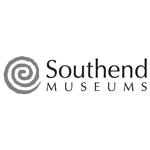
Turner was a commercial illustrator and painter best known for naval and other maritime and aviation subjects. He was the eldest of three children of a London-born machine fitter, also called Charles Edward, and his wife, Grace, and was born in Beswick, Manchester, on 14th September 1883. The elder Charles died before 1901 while the family were living in Chorlton, when Grace, by then 38, was working as a ‘monthly nurse’ and 17-year-old Charles as a ‘clerk’. Turner’s training may have been through night school, but from 1904 he worked for the printing firm of Taylor, Garrett, Evans and Co. Ltd in Manchester, and by 1916 was manager of their ‘Artist and Photo’ departments. From 1905 to 1921 he was also a member of the Amalgamated Society of Lithographic Artists, Designers, Engravers and Process-Workers.
From 1916 Turner was attached to HMS ‘President II’, a naval shore-establishment then at Chingford, Essex, as a Royal Naval Volunteer Reserve photographer, apparently for the Royal Naval Air Service. He was initially rated as a Petty Officer (Mechanic). In 1917 he was commissioned Temporary Sub-Lieutenant RNVR and put in charge of the RNAS Photo Section until apparently moving with it to Calshot in Hampshire. Gazetted Temporary Lieutenant from October, he transferred to the Air Force List as a ‘Captain (Technical Branch)’ in 1918 – the founding date of the RAF by the amalgamation of the RNAS and the Royal Flying Corps. Standing down at the war’s end in November, he was placed on the unemployed list in May 1919. He occasionally used the rank ‘Captain’ in later civilian life. In modern RAF rankings, this rank equates to Flight Lieutenant.
Between 1912 and 1919 Turner showed five pictures at the Walker Art Gallery, Liverpool, two at the Manchester City Art Gallery and one at the Royal Academy: the last, The Channel Patrol…, was illustrated in The Sphere magazine and is now in the Fleet Air Arm Museum.
Turner appears to have started doing illustrative work for The Sphere from 1914: he also worked for the Illustrated London News and its associated publication, The Sketch. Other commercial projects included the design of ‘Churchill Cigar’ boxes, railway and shipping company posters and postcards, and posters for the London Underground. His landscape views appear to have been mainly urban and often well-peopled.
In 1939 Turner was living in Chingford, noted as an ‘Artist, Illustrator & Painter… RAF Volunteer Reserve Captain’, and as ‘divorced’. In December 1939 he remarried Rita May Offlow, and in 1940 the Turners bought Treliss Cottage (now Grade II listed) in West Looe, Cornwall, where he lived and worked for the rest of his life. Turner died, aged 81, on 7th July 1965 at Liskeard, his wife following in May 1978.
Although a good painter and technically accurate in the representation of his subjects, his name as a ‘gallery artist’ did not emerge to the same degree as others who started the same way, including Norman Wilkinson and Montague Dawson. This may have been partly due to the documentary nature of his subjects but also, perhaps, his artisan background.
Turner’s second name is frequently but wrongly given as ‘Eddowes’, which may derive from a mistaken belief that he was related to the Nottingham-born animal painter, William Eddowes Turner (1836–1904). All official records give ‘Edward’ though he did not always include the ‘E’ in his signature.
Summarised from Art UK's Art Detective discussion 'Can anyone supply more biographical information on Charles E. Turner than appears in Archibald's 'Sea Painters'?'
Text source: Art Detective












